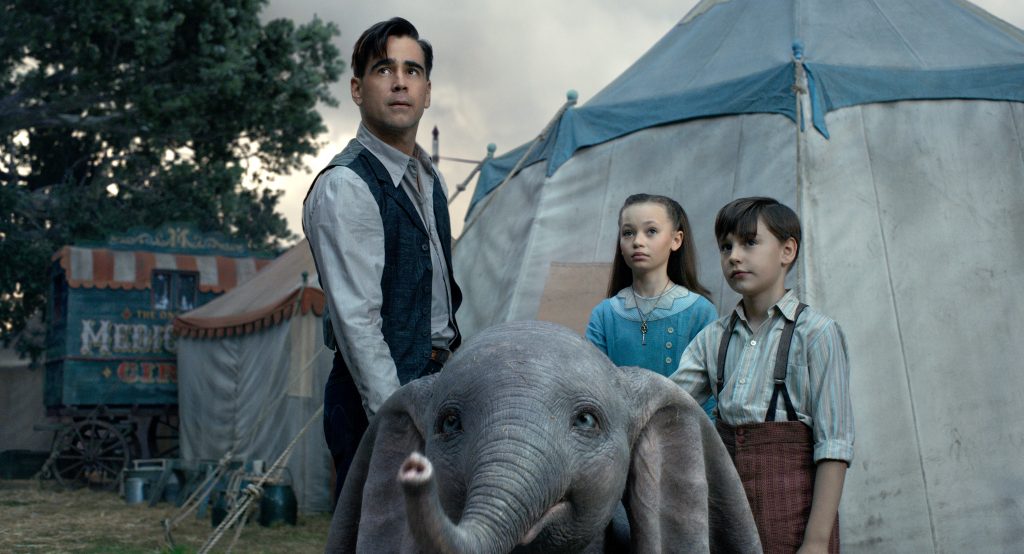Walt Disney Pictures’ recent habit of remaking its own films into live-action versions has been called a lazy cop-out for story ideas — and perhaps justifiably so — but the idea is nevertheless a clever one. Take a set of films already commended as timeless, jazz them up with fresh actors and modern film technology, and you’re sure to attract excited fans and curious skeptics alike.
Last week, “Dumbo” became the latest installment in this effort to reawaken Disney nostalgia. And while a stunning animation upgrade makes the memorable title character almost as adorable as the original, ultimately the film never takes off as well as our dear flying elephant does.
The challenge of the Disney remake is to retain the familiarity of the classic original and also enhance the story with enough complexity (i.e., plot twists and more character development) so as to make the new film worth seeing on its own.
Striking that balance is what has made some previous repeat titles rather successful: “Cinderella” (2015) added layers to both the title character and her prince, while “Beauty and the Beast” (2017) made Maurice and Gaston less of caricatures.
In being given the opportunity to remake the 1941 film, it would seem that director Tim Burton had struck a gold mine. The original “Dumbo” is the epitome of classic Disney, but is simple enough to leave plenty of room for expansion. In Rotten Tomatoes’ rankings of all Disney animated feature films, it placed fourth — beating out all Disney princesses except for “Snow White.”
According to the site’s critics, “ ‘Dumbo’ packs plenty of story into its brief runtime [just 64 minutes], along with all the warm animation and wonderful music you’d expect from a Disney classic.” By all appearances, Burton had the chance to turn a brief, beloved film from 78 years ago into another modern success.
The problem is that for all the flashy effects and array of new characters, the 2019 makeover did nothing to make “Dumbo” any more captivating. In fact, the attempted enhancements just dragged the film down.
Although the film incorporates artistic nods to its predecessor ranging from musical hints of the original soundtrack to snatches of the old script, the transition to a nonmusical without talking animals can’t help but diminish the classic charm. Besides Dumbo himself, humans rather than animals assume the main character roles.
Rather than teasing elephants, singing storks, and controversial crows, we see a vivacious circus troupe, a zany entrepreneur, and a suave trapeze artist.
Most importantly, Milly and Joe Farrier (Nico Parker and Finley Hobbins), the children of circus actor and just-returned World War I veteran Holt Farrier (Colin Farrell), serve as the ostracized elephant’s caretakers and trainers instead of the chipper mouse Timothy from the 1941 version.
When they discover their little friend can fly, the Farriers see a way to not only save their struggling circus but also reunite Dumbo and his mother.
The incorporation of these human characters could have added layers of human emotion, connection, and depth to the film, but sub-par character development and acting prevent that.
The biggest disappointment here was the children themselves. Parker and Hobbins’ inability to display convincing emotion — their facial expressions and line delivery were repeatedly flat — made their characters difficult to sympathize with.
In the scene that is supposed to serve as Milly and Holt’s loving moment of reconciliation, neither a tear nor even a hug passes between them. Danny DeVito’s performance as the bumbling ringmaster, Maximilian Medici, was perhaps the most satisfying, but this was not enough to sustain interest in the human characters’ stories.
Had the non-Dumbo characters been more endearing and developed, Burton’s remake could have added a powerful message about the importance of familial love.

© DISNEY, ALL RIGHTS RESERVED
But as it was, the best moments of the film were the most memorable ones from the original: when little Dumbo wows the circus audience for the first time, and when he cuddles with his imprisoned mother while the “Baby Mine” track plays.
In the latter scene, Mrs. Jumbo unfortunately does not actually rock her baby with her trunk as in the old version (since that would contradict the remake’s more realistic presentation of the elephants’ dimensions), but the tender caresses with their trunks and Dumbo’s big blue eyes still make it a tear-jerker moment.
It is true that both of those scenes are recreated masterfully — but they happen in the first 40 minutes of the movie. After that, the plot grows wearisome, since it focuses on the characters we care less about for far too long.
There is a reason why the original “Dumbo” succeeded at just 64 minutes. Dumbo first stole our hearts because he is a goofy-looking elephant who can dazzle a crowd and who loves his mama more than anything. Everything this remake adds just comes off as fluff to fill two hours in an attempt to make it a modern, “serious” movie.
To really get the most out of this movie, rent it once it’s available to stream and skip to the classic scenes. You know, the ones that are about Dumbo.
Or better yet, just watch the original.
Sophia Buono is a writer living in Arlington, Virginia.
SPECIAL OFFER! 44 issues of Angelus for just $9.95! Get the finest in Catholic journalism with first-rate analysis of the events and trends shaping the Church and the world, plus practical advice from the world’s best spiritual writers on prayer and Catholic living, along with great features about Catholic life in Los Angeles. Subscribe now!

